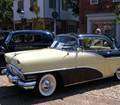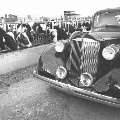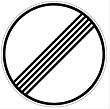|
Re: What was the first Packard to have seat-belts, if at all?
|
||||
|---|---|---|---|---|
|
Home away from home

|
As far as I know, no Packards ever came factory equipped with seat belts.
According to Wikipedia: "Seat belts became standard equipment in the mid 1960s. American car manufacturers Nash (in 1949) and Ford (in 1955) offered seat belts as options, while Swedish Saab first introduced seat belts as standard in 1958. "After the Saab GT 750 was introduced at the New York Motor Show in 1958 with safety belts fitted as standard, the practice became commonplace. "In 2001, Congress directed NHSTA to study the benefits of technology meant to increase the use of seat belts. NHSTA found that seat belt usage had increased to 73% since the initial introduction of the SBR system. "In 2002, Ford demonstrated that seat belts were used more in Fords with seat belt reminders than in those without: 76% and 71% respectively. "In 2007, Honda conducted a similar study and found that 90% of people who drove Hondas with seat belt reminders used a seat belt, while 84% of people who drove Hondas without seat belt reminders used a seat belt. "Observational studies of car crash morbidity and mortality,[71][72][73] experiments using both crash test dummies and human cadavers indicate that wearing seat belts greatly reduces the risk of death and injury in the majority of car crashes. "This has led many countries to adopt mandatory seat belt wearing laws. It is generally accepted that, in comparing like-for-like accidents, a vehicle occupant not wearing a properly fitted seat belt has a significantly and substantially higher chance of death and serious injury. One large observation studying using US data showed that the odds ratio of crash death is 0.46 with a three-point belt, when compared with no belt.[74] In another study that examined injuries presenting to the ER pre- and post-seat belt law introduction, it was found that 40% more escaped injury and 35% more escaped mild and moderate injuries. "The effects of seat belt laws are disputed by those who observe that their passage did not reduce road fatalities. There was also concern that instead of legislating for a general protection standard for vehicle occupants, laws that required a particular technical approach would rapidly become dated as motor manufacturers would tool up for a particular standard which could not easily be changed. For example, in 1969 there were competing designs for lap and 3-point seat belts, rapidly tilting seats, and air bags being developed. But as countries started to mandate seat belt restraints the global auto industry invested in the tooling and standardized exclusively on seat belts, and ignored other restraint designs such as air bags for several decades. "As of 2016, seat belt laws can be divided into two categories: primary and secondary. A primary seat belt law allows an officer to issue and citation for lack of seatbelt use without any other citation, whereas a secondary seat belt law allows an officer to issue a seat belt citation only in the presence of a different violation. In the United States, fifteen states enforce secondary laws, while 34 states, as well as the District of Columbia, American Samoa, Guam, the Northern Mariana Islands, Puerto Rico and the Virgin Islands, enforce primary seat belt laws. New Hampshire lacks both a primary and secondary seat belt law." I have and always use the lap belts in my '55 Clipper and I always use my seat belts in my regular cars. Despite your complaints about previous versions of seat belts, the fact is, you are a lot less likely to be injured or killed in an accident when you wear them properly. It is extremely dangerous to rely on air bags without wearing your seat belts. The system is designed to work in coordination.
Posted on: 2016/4/7 12:15
|
|||
|
You can make a lot of really neat things from the parts left over after you rebuild your engine ...
|
||||
|
||||
|
Re: What was the first Packard to have seat-belts, if at all?
|
||||
|---|---|---|---|---|
|
Forum Ambassador
|
Quote:
Despite your complaints about previous versions of seat belts, the fact is, you are a lot less likely to be injured or killed in an accident when you wear them properly. No disagreement on the safety aspect. Even though I bitched about the earlier belts I was using them. If I hadn't been wouldn't have known how much of a PIA they were. California has been a primary state for quite some time but even when it was still optional the safety aspect won out. I will say that lap belts only are better than nothing but when too loose or tight or otherwise not strapping the person in the proper place they have been known to cause some significant abdominal injuries trying to restrain the person. Those like HA52 who have discreetly managed to install the 3 point belts in their cars are to be commended. Unfortunately so many of our Packards just do not have the geometry or strength for the shoulder restraints. I gave up on trying to figure a safe yet aesthetic way to install them in a HT with the folding seat backs and no structural metal in the roof.
Posted on: 2016/4/7 12:50
|
|||
|
Howard
|
||||
|
||||
|
Re: What was the first Packard to have seat-belts, if at all?
|
||||
|---|---|---|---|---|
|
Home away from home
|
I've wondered myself whether 3 point seat belts could be installed in a Packard or not.
John
Posted on: 2016/4/7 15:20
|
|||
|
||||
|
Re: What was the first Packard to have seat-belts, if at all?
|
||||
|---|---|---|---|---|
|
Home away from home

|
It might be possible to mount 3-ways belts in the back seats of some Packards, but I am guessing here. I don't see a problem mounting them to the floor; but I am not quite sure where the shoulder belt could be mounted. I know 3-ways could not be used in the front seats of two-door hardtops or convertibles, and I don't think the B pillar on most Packards could accommodate the shoulder belt mounting.
Posted on: 2016/4/7 15:28
|
|||
|
You can make a lot of really neat things from the parts left over after you rebuild your engine ...
|
||||
|
||||
|
Re: What was the first Packard to have seat-belts, if at all?
|
||||
|---|---|---|---|---|
|
Home away from home

|
Quote:
First rule of thumb in Packard history: never use Wikipedia as a reference or yardstick of accuracy. ? Wikipedia will also tell you (last time I checked) that there were 10 Packard Request cars made. Absurd. ? Wikipedia will also tell you (or used to) that Earle C. Anthony put up the first neon sign on his dealership (wrong)...and that he first brought TWO neon signs back from France (wrong again). And that he paid a certain amount for them (wrong 3 times). And other silliness. ? And there is a lot more silliness said on Wikipedia-particularly in this case about Packard. Wikipedia is run by people who get themselves installed as "wiki-editors"... which means absolutely zero about nothing. Just about anyone who applies to be a "wiki-editor" gets to be a "wiki-editor." I can tell you for certain that when accurate info is posted and some "wiki-editor" objects to it in favor of a stupid myth, the accurate information is removed and replaced by the absurd myth! This has actually happened. Wikipedia is a home-grown "history" and "facts" by whoever does the most "wiki-editing" and has nothing necessarily to do with facts, but rather how many "wiki-folk" agree that the moon is made of green cheeses and there is no truth detector... only who can dominate the editing process. Sometimes it is right... but as a source of factual history...? Often not. History determined on the basis of who shouts the loudest or who stands in the greatest numbers is not history. Nor is it fact. If 900 people in a room say the world is flat and 2 say it is round...does that mean those two people are wrong? ? Packard absolutely, positively, did produce vehicles with factory-installed and dealer-installed seatbelts. I have owned two of these cars over the years. You can also look in the 1956 Packard factory-issued Salesman's Data Book and it will very clearly show accessories including factory seatbelts. And yes, the outer belt clipped on the door panel when not in use. I know of a 1956 Caribbean that was ordered new with factory seatbelts. ? Ford's 1955-56 safety program was known as "Lifeguard Safety" and they even re-vamped one of their concept cars (the 1954 Mercury XM-800) to a safety-ized Version #2. This meant re-designed instrument panel, relocated controls, safety-dished steering wheel and other changes. All done by Creative Industries of Detroit. These are facts that you will not see on the internet. As for factory seatbelts... they were offered on many cars a lot earlier than stated here. And in 1966, they had to be offered (and in many cases) installed in the rear too! ? My 1966 Cadillac Eldorado has them front and rear. Factory. And I am 2nd owner. Yes, it is in the factory and dealership salesman's info. ? When I worked for Ford on the original Mustang, we had to do them in the rear for 1966. ? I had dealer-installed seatbelts in my 1963 Ford XL convertible. ? I had factory Deluxe seatbelts in my 1964 Oldsmobile Starfire convertible. ? I had Deluxe factory seatbelts in my 1970 Dodge Challenger convertible (they had 2 kinds of factory-installed seatbelts that year: 1.) standard 2.) Deluxe. Deluxe were push-button operated and had a white ring of plastic around them with the rest color-keyed to the car. It also came with a red warning light on the right side of the instrument panel that said "Seat Belts"... ? I had factory seatbelts in my 1971 Dodge Challenger convertible. Again, it also came with an optional red warning light on the instrument panel. ? I had factory seatbelts AND shoulder belts in my 1971 Charger R/T SE. ? My 1969 Continental Mark III has factory seatbelts, shoulder belts and warning lights... all factory. And Tucker had one of the first modern safety-oriented cars with the passenger side of the instrument panel recessed as a padded safe haven supposedly in case of an accident. And a pop-out windshield. There was indeed a Tucker running around Detroit in the 1950s with seatbelts in it. I saw it...in the 1950s. As for 3-point belting, it is far more sensible to use 3-point racing style belts if this is such an absolute necessity rather than attempting to poke holes in the vehicle roof which was first, never designed to anchor shoulder belts... and second, may be weakened even further by doing such stuff. The important thing about seatbelts is to wear them snugly. The worst thing one can do is to fall into the mistaken notion that merely buckling into a belt will solve all safety issues. There is a condition called "submarining" which involves an occupant actually sliding out from under the belts and ending up compressed down and forward (often very painfully injured or worse-as in fatality) under the instrument panel. I have personally witnessed live results of this condition and I assure you, it is not pretty. Anyway, Packard definitely offered factory seat belts as options on V-8 models.
Posted on: 2016/4/7 19:33
|
|||
|
||||
|
Re: What was the first Packard to have seat-belts, if at all?
|
||||
|---|---|---|---|---|
|
Home away from home

|
Front seat belts were mandated for 1965 cars.
Seat belts in old pre-war Packards won't achieve very much. If the car has sidemounts the results of a head on collision will be more favorable because the oncoming car will ricochet off the sidemount. In a broadsides collision they will serve only to hold you in place for mutilation and death. In the postwar cars they will prevent decapitation which was a Packard trademark in a direct head on. Installation thereof needs to be carefully thought through otherwise the anchors will break free and launch the occupants at the millisecond of maximum deceleration. The seats are another problem because in a high speed crash they will be launched forward and result in a decapitation. For this reason I will absolutely not ride in a vehicle with the seat back reclined. The engineering involved in these areas is pretty involved.
Posted on: 2016/4/7 20:03
|
|||
|
||||
|
Re: What was the first Packard to have seat-belts, if at all?
|
||||
|---|---|---|---|---|
|
Home away from home
|
I'm finding this discussion very interesting. My 1970 Nova has both lap and shoulder belts from the factory in it. Though the shoulder belts are non retractable, you fold them in 2 and insert them in a pair of clips along the headliner above the front door when not in use.
John
Posted on: 2016/4/7 21:49
|
|||
|
||||
|
Re: What was the first Packard to have seat-belts, if at all?
|
||||
|---|---|---|---|---|
|
Home away from home

|
My wife's 59 2 door Fairlane didn't come with seatbelts, maybe it was an option back then?
When I look at the pictures in the European accident I see the advantages of the prewar heavy duty frames! It looks like the Kia run into a concrete wall and bounced of. If I had to pick in which vehicle I wanted to be and couldn't wear a seat belt it would be the 33 packard and not the Kia.
Posted on: 2016/4/8 6:29
|
|||
|
I can explain it to you but I can't understand it for you
 Bad company corrupts good character! Farming: the art of losing money while working 100 hours a week to feed people who think you are trying to kill them |
||||
|
||||
|
Re: What was the first Packard to have seat-belts, if at all?
|
||||
|---|---|---|---|---|
|
Home away from home

|
All I can say is that non-retractable 3 point belts are terrible. For 5 min you feel like You're in a Race car, but after that they are just annoying. No wonder people didn't wear belts back then. I changed my 69 Porsche from 3 point fixed belts to modern belts with a retractor reel and they are so much better. I also plan to put 3pt retractor belts in my 53 Clipper.
Posted on: 2016/4/8 8:57
|
|||
|
1953 Clipper Delux Club Sedan, 1953 Caribbean, 1969 912, 1990 Miata
|
||||
|
||||








